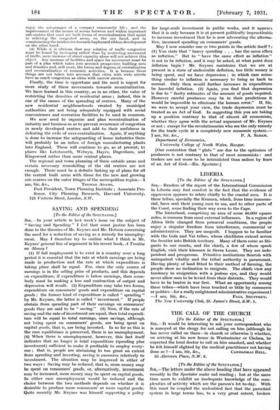THE PLANNING OF LONDON—THE PROBLEM OF RECENTRALIZATION
[To the Editor of the SPECTATOR.] SIR,—In the last few years the planning of the London Region has been dealt with or considered from many different points of view. In addition to concerted efforts to plan " regionally," a succession of proposals has been made to improve circulation and housing in central areas. The latter include the schemes for rebuilding Charing Cross Bridge and Station ; for drastic widening of streets in built areas, as proposed by Major Crawfurd, M.P., in the Report of the Royal Commission on Transport ; for the erection of block dwellings over railway tracks, which is being strenuously advocated by Mr. Alfred C. Bossom, L.C.C. ; and for permitting greater height and, therefore, greater density of building.
I make no criticism of any particular proposals, but submit that in so far as such schemes would have the effect of promoting greater aggregation of business, of buildings and of traffic in the main centres, their result would be to increase both the extent and the virulence of the evils of congestion. Plans for the improvement of circulation and of industrial and housing conditions in London should be directed towards the end of promoting wider dispersal of industry and population, as well as the resultant traffic, into subsidiary centres and new centres. Let me indicate a few of the most important considerations that bear upon this suggestion :
(1) The first report of the Greater London Regional Planning Committee showed that between 1921 and 1928 the County of London decreased by 1.21 per cent., while the ring to the Metropolitan District boundary increased 12.47 per cent. and tho outer ring of the Greater London Region 18.90 per cent. Even more significant than this diffusion of population outwards is the fact that, coincident with it, there is growing up a new system or form of distribution of economic activities that have hitherto been centralized in a few places. Transport changes should bo made to assist this process and not to try and arrest it by providing added facilities for more concentration in the old centres.
(2) The great increases in size and geographical extent of urban aggregations have meant that great numbers of people have now to travel twenty or thirty miles between homes and places of work, as against half this distance thirty years ago. As the distances have lengthened the loss of time, cost and degree of fatigue in travelling have increased. Hence one reason for the growing demand for new shopping and amusement centres which is being followed in some cases by the dispersal of industries. There are scores of new centres in London that have become equipped so as to provide locally for all social needs except means of occupation, for a large proportion of the inhabitants ; and there are some satellite centres that are almost fully self-contained.
Instances of the former are Golders Green, Streatham, Kingston and Reigate, with their large and growing shopping districts and increasing number of theatres ; and of the latter, the garden cities of Letchworth and Welwyn, and industrial communities like Luton and Woking. Becontree is an example of publicly organized recentralization.
(3) The development of new centres in semi-rural districts and on main line railways where works can be established and workers have housing accommodation provided near their work, as well as
enjoy the advantages of a compact community life ; and the improvement of the means of access between and within important sub-centres that exist are both forms of recentralization that assist in relieving the congested areas, on the one hand, and in counteracting the tendencies towards haphazard ribbon development on the other hand.
(4) While it is obvious that any solution of traffic congestion must be found by increasing rather than by restricting movement of traffic, mere increase of street capacity alone will not achieve this object. Any increase of facilities and space for movement must be part of a plan which takes into account prospective building uses and densities and, still more, the forms and degrees of centralization and recentralization of economic activities. It is because these things are not taken into account that cities with wide streets have as much congestion as cities with narrow streets.
Finally, the time is opportune and the need is urgent for more study of these movements towards recentralization. We have learned in this country, as in no other, the value of restricting the densities of residential areas ; indeed, this is one of the causes of the spreading of centres. Many of the new residential neighbourhoods created by municipal authorities are not being adequately equipped with social conveniences and recreation facilities to be used in common.
We now need to organize and plan recentralization of industry and business so as to prevent recurrence of congestion in newly developed centres and add to their usefulness in defeating the evils of over-centralization. Again, if anything is done to increase the safeguarding of home industries there will probably be an influx of foreign manufacturing plants into England. These will continue to go, as at present, to places like Letchworth, Welwyn, Hayes, Dagenham, and Kingswood rather than more central places.
The regional and town planning of these outside areas and certain necessary remodelling of the old centres are not enough. There must be a definite linking up of plans for all the central built areas with those for the new and growing sub-centres on the outer fringes of the metropolitan region.—I
Past President, Town Planning Institute ; Associate Pro- fessor, City Planning Research, Harvard University.
121 Victoria Street, Landon, S.W.











































 Previous page
Previous page